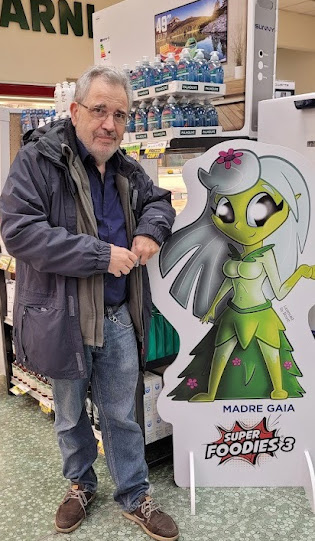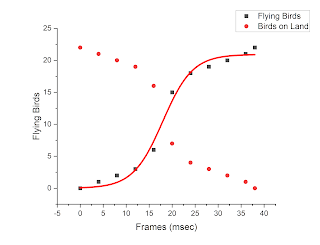Liliana Lippi, my mother in law, died last week at 101. You see her in a picture taken for her 101th birthday, last July. with her two daughters and her son (on the left, my wife, Grazia). She also had four grandchildren and two great-granddaughters. What was the secret of her long life? Probably not a single factor, but perhaps the main one was that she managed to attain a certain harmony with the people and the things that surrounded her, as a good holobiont should do.
I already wrote about Liliana's Longevity in a previous post published for her 100th birthday. Here is a longer and updated version.
Her life as a young woman was typical of that age, when middle-class women, as she was, were supposed to be housewives and no more. She could cook, sew, clean, and perform other household skills. She never learned how to drive a car -- she couldn't even ride a bicycle. As most Florentines at that time, she couldn't swim and she was always a little afraid of the sea. No one remembers having ever seen her in a swimsuit.
That doesn't mean her life wasn't rich in emotions and satisfactions. She had several suitors and the one who finally could touch her heart was a young Sicilian student who was studying at the Art Institute of Florence, close to where she lived. You may wonder how courting could take place in an age without telephones and social media: Liliana told me that the boy she eventually married would walk up and down along the street where she lived until she noticed him! You can find the same technique to get the attention of girls in Boccaccio's Decameron, written six centuries earlier! Probably, Sumerian boys would do exactly the same thousands of years ago.
Liliana's sentimental life was adventurous. One reason was that, at the time, it wasn't so usual for a Florentine girl to have a Sicilian fiancé. Southerners were often shunned in Florence, just like Africans are, nowadays. Consider that the family of the boy (Giovanni) was not rich, and you have a recipe for contrasts in the family. Liliana's father, Mario, was never happy about this prospective marriage, but one of the characteristics of Liliana's personality was that she was stubborn about her choices. She wanted that boy and she had him, despite all that happened, including the war starting, Giovanni being drafted and sent to fight in Africa, then coming back to Florence and being wounded at a leg in a gunfight among the factions battling in the civil war.
Eventually, Giovanni and Liliana did manage to get married in 1946. Then, they both moved to Sicily over a slow steam train that took two days to travel from Firenze to the city of Messina, where Giovanni's parents lived. Liliana remembers Sicily as an exotic place: a sort of wonderland. She and Giovanni were met at the train station by Giovanni's relatives who had arranged their transportation using a traditional, brightly colored Sicilian cart pulled by a donkey. And the Sicilians, in turn, were awed by this Florentine girl whom they considered a princess, of a sort.
It seems that Liliana had a good time in Sicily, the problem was that there was no job there for Giovanni and that the home where they were living hosted the whole family, Giovanni's parents, and his sisters and brothers. When Liliana got pregnant of her first child, they came back to Florence where they settled in the house that her grandfather had bought for the whole family. Giovanni worked as a woodcarver, a skill he had learned at the Art School, while Liliana was a housewife. She had children, grandchildren, and even great-grandchildren. Giovanni died in 2003 at 89, Liliana survived him for almost two decades, dying at 101 in peace at her home, in her bed, surrounded by her children. She had been living in that same home since 1929.
Despite some problems typical of old age (mainly arthritis), Liliana lived a reasonably healthy life up to her last 2-3 weeks. Remarkably, up to the last moments, she showed no signs of dementia, so common with old people nowadays. Of course, she would forget things and sometimes lose track of the conversation, but 15 days before dying, she was still sewing without needing glasses. Up to the very last day, she recognized her children and she was obviously happy to have them close to her.
So, what was Liliana's secret for such a long life? Diet, exercise, medicines? Or what?
Let's start with food. Among the things she never ate there was junk food: pizza, hamburgers, Chinese food (she didn't even know what Chinese food was), or soft drinks. She didn't drink alcohol, not even wine. About what she ate, hers was a relatively high-protein diet in the form of eggs, chicken and rabbit meat, and also the boiled meat used to prepare the soup, a habit reported to have scandalized the British travelers who visited Florence at the time of the "Grand Tour. She also loved the fat part of the meat, including the fat coming with prosciutto (ham). She also drank milk every day, in the morning and before going to bed. About carbohydrates, she ate bread, very rarely sweets, and she was also fond of the kind of Italian soup we call "minestra in brodo." Personally, I hate it but maybe should reconsider after seeing how well it worked with her! In terms of vegetables, Finally, she was not especially fond of vegetables, which always appeared cooked at her table-- she seemed to be somewhat suspicious of salads. In short, not a ketogenic diet, but surely not vegetarian.
What else? She didn't smoke, she drank a little coffee, but that was her only recreational drug. She had an active life, but she wouldn't even dream of "exercising" in a gym or running along the street. She did watch TV, a little, when she was free of the various chores at home. But she never was interested in the news or in politics. Not an intellectual, she was nevertheless a voracious reader of all kinds of books, newspapers, and magazines.
In terms of medicines, she avoided them as much as possible. When she was in her 70s she was found to have very high blood pressure and her doctor had her taking the full spectrum of pressure-lowering drugs: beta-blockers, diuretics, and other stuff that I can't exactly classify. I don't know how effective these drugs were. In any case, she never took statins to reduce her cholesterol level which was supposed to be in the normal range. Or maybe not, I have no idea of when she last checked that, possibly 10 years ago or more.
During the Covid period, her physician insisted to vaccinate her with the Pfizer thing, last spring. I don't think it had any effect, good or bad, we never had her tested for the coronavirus since she showed no symptoms of it. What I can tell you is that we never isolated her, never had her wear a mask, her relatives newer wore a mask when staying with her, and we never prevented her from seeing her great-granddaughters. She enjoyed their company a lot, nearly up to the last moments of her life.
In the end, I don't want to stretch too much the analogy with holobionts, but there is something in living a good and long life that has to do with attaining that kind of harmonious equilibrium that is the characteristic of holobionts. They are creatures living in symbiosis with each other in a non-hierarchical network. We humans can do that if we are well connected with the other humans surrounding us. Of course, there does not exist a perfect set of interactions but, on the whole, is the way we are built to live: part of the human social holobiont.
Liliana surely was a good social holobiont. I told you that she was stubborn, but that was when it was about herself. With the others, she was very flexible, never trying to impose anything on anyone, accepting things as they came. And she had a rich social life: her home was always open to relatives and friends coming for lunch -- she was the hub of a remarkable network of interactions among people. No one seems to remember her going mad at something or someone. Maybe this is the secret of a long life, maybe not. And so it goes.
Here is Liliana for her 100th birthday. You see with her daughter (Grazia) granddaughter (Donata), and great-granddaughter (Aurora). All of them are daughters of the Goddess Gaia, connected over nearly one century of life, a snapshot of the great chain of beings that keeps turning and turning, and has been doing that for billions of years, and will keep doing that for many more years.














